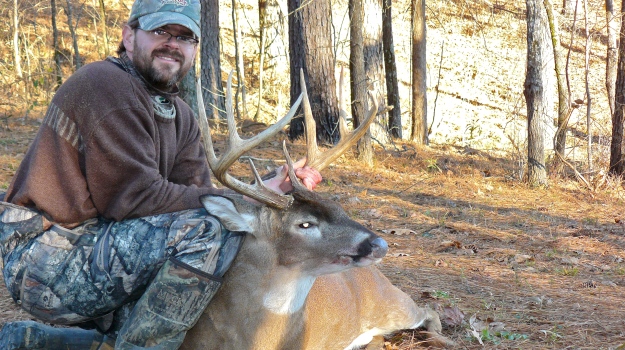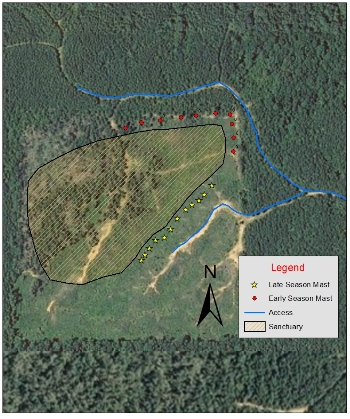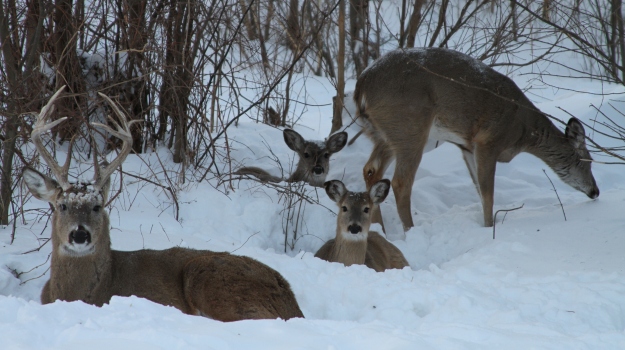
Improve Hunt-ability with these Tree Planting Tactics
By Dudley Phelps
Every summer a few weeks after turkey poults have safely hatched and days slowly begin getting shorter, thoughts and daydreams transition from “what can I do for my birds” to “what can I do for the deer.” I think it’s pretty safe to say most of our thought processes follow the same calendar. Even though its engrained in our heads how important it is to follow a long-term management plan, that small block of thinned pines you’ve been hankering to burn to create a scratching and strutting hotspot, suddenly needs to be left alone to grow thicker for deer cover. The same can be said for that food plot you planted in chufas last spring, now you wish you would have saved it to plant in Maximum for this fall. Or what about all those egg-eating coons you were going to trap this coming season? Well when are you going to have time to run all those new trail cameras and hunt that old buck if you’re busy on the trap-line?
These so-called seasonal mindset changes happen to just about every gamekeeper, and the good news is all of these practices are beneficial and rewarding, even if they do weigh a little more towards either fur or feathers. So what are some things we as hunters and land managers can do to benefit both ends of the spectrum? To be more specific, what are some practices we can implement that will improve deer hunt-ability AND provide a food source for the “sultans of spring?” Since one of my main passions aside from deer and turkey hunting is trees, and the three can go hand in hand, I’m going to cover a few tree planting strategies that work well for both game species.
In a nutshell, it’s all about the species of trees you choose to grow, and most importantly where you plant them that can make such a drastic difference. At Nativ Nurseries, we raise a wide spectrum of species– all beneficial for wildlife, but again it’s about where you put them that is so key when it comes to improving huntability. Most of us have learned by now how to grow and hold more mature bucks on our properties, but holding mature bucks and getting them in your sights during daylight hours are two totally different ballgames.
Turkey Trees on Your Roads
The almighty oaks, my personal favorite, are by far the most popular trees to plant when it comes to wildlife, but a common mistake I’ve seen over the years is in the choice where they, and other fall and winter dropping mast trees are planted in respect to improving hunt-ability for deer. In my opinion, the single biggest mistake a tree planting deer hunter can make is to plant “acorn trees” along open roads and other human access routes to deer stands. To be a more effective deer hunter, it makes sense to NOT attract deer to the same roads and trails you use to access them for hunting. Think about it! Why on earth would you want to bump multiple deer en route to the hunt? All this will accomplish is to encourage them to wait until way after dark to come out and eat.
 The best solution is to establish plants and mast trees that aren’t attractive to deer in the fall and winter all along these pathways. But that doesn’t mean you have to avoid wildlife friendly, mast producing species altogether. Just make a point to plant these human access routes in something wildlife can utilize at times of the year other than deer season. I’ve found the best scenario is to establish spring and summer dropping “turkey trees” such as: black cherry, blackgum, and red mulberry along your access routes, or any other species such as plums, dogwoods, or even pines. Save your oak seedlings and other fall and winter mast cropping species for everywhere else. It’s not that deer won’t utilize these turkey trees, in fact they relish ‘em, but not at a time of year when it can interfere with you bagging the buck you’ve been after. This strategy alone will greatly reduce your human impact when human impact is a no-no, and on the flip side give your birds more reasons to stick around all summer.
The best solution is to establish plants and mast trees that aren’t attractive to deer in the fall and winter all along these pathways. But that doesn’t mean you have to avoid wildlife friendly, mast producing species altogether. Just make a point to plant these human access routes in something wildlife can utilize at times of the year other than deer season. I’ve found the best scenario is to establish spring and summer dropping “turkey trees” such as: black cherry, blackgum, and red mulberry along your access routes, or any other species such as plums, dogwoods, or even pines. Save your oak seedlings and other fall and winter mast cropping species for everywhere else. It’s not that deer won’t utilize these turkey trees, in fact they relish ‘em, but not at a time of year when it can interfere with you bagging the buck you’ve been after. This strategy alone will greatly reduce your human impact when human impact is a no-no, and on the flip side give your birds more reasons to stick around all summer.
Two good choices to plant your oaks and other mast trees that drop during deer season can be 1) PARALLEL to, but offset a good ways from your access roads, and 2) PERPENDICULAR to other access roads, preferably at present or future stand locations.
Parallel Plantings for Deer
The first trick of the two I just mentioned is planting trees that drop mast during deer season parallel to your access roads. Don’t confuse this play with planting the aforementioned turkey trees that drop in the spring and summer on and along your access routes. I’m talking about planting fall and winter dropping trees on one side of, and parallel to your own road or trail- but offset them from your access, a good stones-throw away. This will encourage deer to travel along your routes, but far enough away from them that they either don’t know you’re going by, or they in time become more accustomed to your traffic thinking danger is going instead of coming, or simply staying put until the danger has passed.
 Every property is sized and shaped uniquely, with differing types of cover and means of access, so there is no set distance you need to offset from your road with this plan, but 75-100 yards is a good rule of thumb. In other words, with this method you’ll be providing deer their own path to follow, and good reason to follow it with plenty of food and no direct human intrusion. We’ve found this method works great along the border of a property or a designated sanctuary as it encourages deer to stay safely on your side of the line, or in your sanctuaries, yet provides easy access to great ambush sites when the timing is right.
Every property is sized and shaped uniquely, with differing types of cover and means of access, so there is no set distance you need to offset from your road with this plan, but 75-100 yards is a good rule of thumb. In other words, with this method you’ll be providing deer their own path to follow, and good reason to follow it with plenty of food and no direct human intrusion. We’ve found this method works great along the border of a property or a designated sanctuary as it encourages deer to stay safely on your side of the line, or in your sanctuaries, yet provides easy access to great ambush sites when the timing is right.
So how do you hunt these parallel offset plantings? Well it’s pretty simple actually. When you decide the wind and weather is right, sneak off of your access road and hunt within range of the path of mast trees you created. These trees you planted in a linear path don’t actually have to be old enough to be dropping mast to provide a great hunting opportunity, just having trees in a line provides an edge effect, much like an old logging trail that deer will follow regardless of whether they are producing or not. You can even improve on this scenario with some strategic treatments such as hinge-cutting or hack-and-squirt, which will provide more light for your seedlings and a distinct path for deer to follow. Not only does this practice of parallelism work, it also makes your property hunt much “bigger,” and you’ll find yourself not having to hunt the same traditional spots over and over again like you’ve done in the past.
Perpendicular Plantings for Deer
Another tree planting and habitat management method that works wonders for the hunt-ability of a property is providing reasons for deer to cross something. That something could be a road, trail, ridge, saddle, field, or even from a neighboring property if need be. By manipulating the food or cover type in a perpendicular, or crossways fashion across another terrain feature such as a ridge, you can narrow down the possibilities of travel– thus directing your deer’s traffic. The main consideration one needs to take before creating a “crosswalk for deer,” is to consider many of the best candidate areas for creating a crossing area may be along a path of human travel. So you have to think a little harder before implementing this trick, because with the wrong placement you can actually do more harm than good.
Understanding the drop times of each mast producing species before choosing what to plant and where, is very important with this technique. A good rule of thumb is to plant the early droppers “earlier,” or closer to where you may park the truck, and the late droppers “later,” or further on down the ridge or road. That way, you don’t have to travel very far from the cabin or parking area, and thus negatively impact your property’s deer so early in the season if your crosswalk plantings are set up with drop times in mind. Once your early crossing has petered out and isn’t dropping any more sawtooth oak acorns, you can then venture past that crossing and hang your stand on the planted persimmon crossing that will be the next hot spot. After the persimmons are gone the next spot on the road may be some Shumard oaks that drop even later. Do you get my point? Each crossing you plant needs to be further down the trail in the order of earliest dropping species to the latest.
Both the parallel and the perpendicular tricks work wonders, but unless you’ve really done your homework its best not to co-mingle the two on the same pathway.
So now that we’ve gone over some tree planting strategies to make a property hunt bigger and easier, now is the time to be analyzing maps and getting your hands dirty making preparations for this coming planting season. And if you have any more questions about when, what, where, or how to plant trees on your place to get the best results, the guys at Nativ Nurseries are all ears and willing to help. You can find Nativ Nurseries contact information our website, www.nativnurseries.com. Happy game-keeping, and best of luck this hunting season.






























